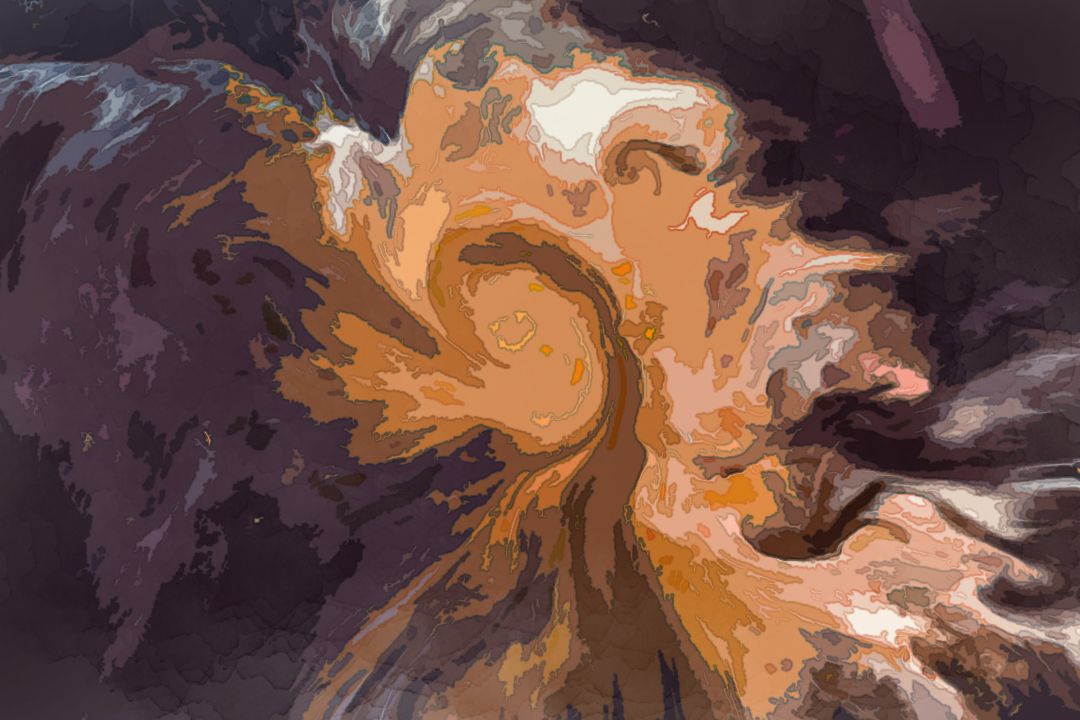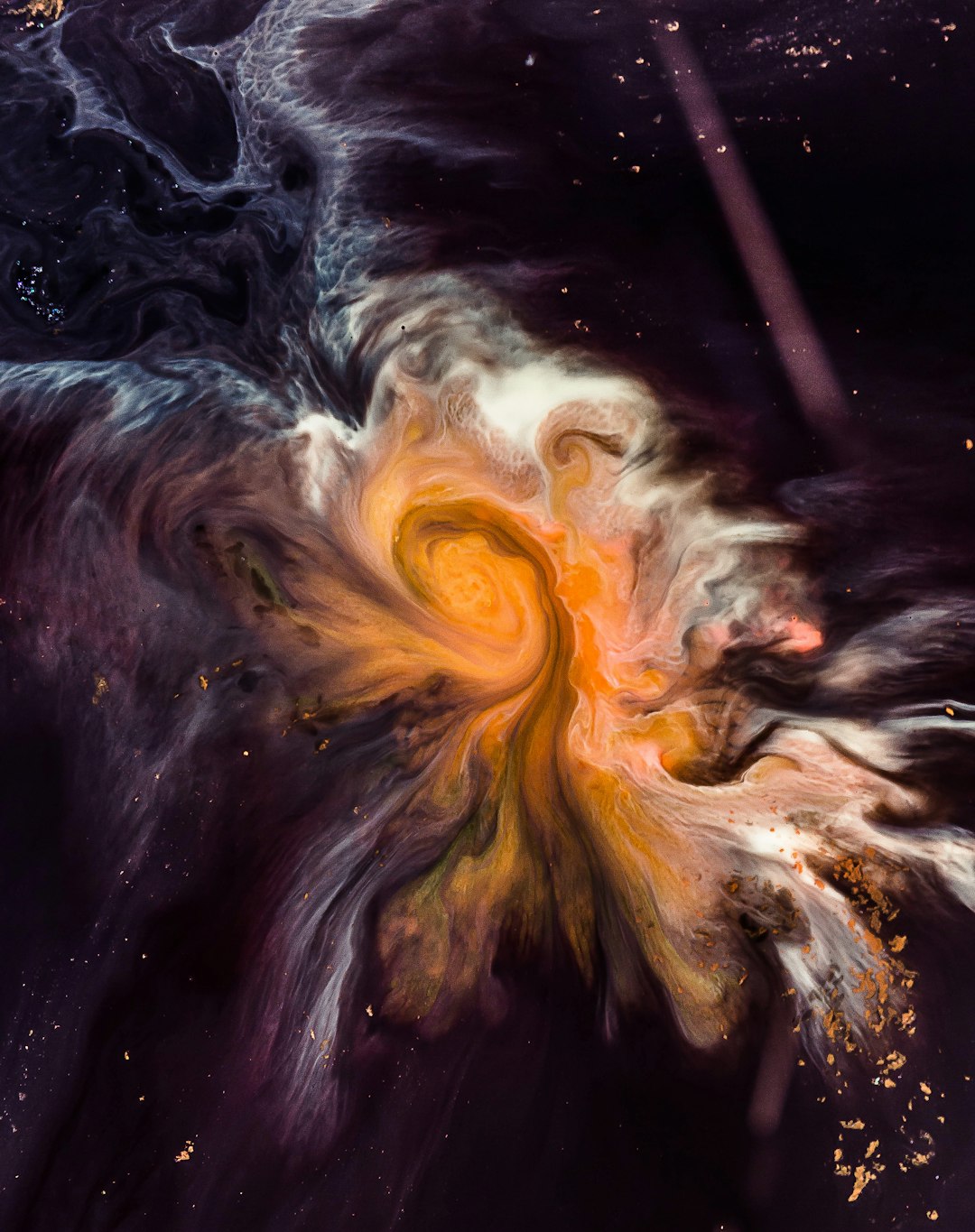The Dissent of Man

Ordered Chaos and the Wonder of Wonder
A canvas unfolded in the quiet recesses of the mind, where thoughts linger like echoes of distant whispers. Abstract swirls of confusion adorned the mental gallery, a kaleidoscope of emotions and forgotten dreams. At the center of this tumultuous storm, an eye, calm and contemplative, peered into the abyss of abstraction, seeking meaning in the chaos.
All colours will agree in the dark.
— Sir Francis Bacon (1561-1626)
... a mysterious voice resonated, as if an unseen maestro directed the symphony of colours, orchestrating harmony within the obscurity of the mind. Once vivid and tumultuous, the swirling hues began to coalesce in the shadows, creating a unity that defied the complexities of the abstract.
As the scene progressed, the memories faded, blending into the tapestry of time. The vibrant colours lost their intensity, dissolving like fragments of a half-remembered dream. It was as if reality itself was a transient illusion, slipping through the fingers of the beholder.
The darkness deepened, embracing the mind's canvas in its velvety cloak. In this obsidian expanse, disparate hues emerged from the shadows, a clandestine symphony of colours waiting to be unravelled. The once chaotic swirls of confusion now transformed, each shade finding its place in the orchestration of a harmonious whole. The revelation unfolded like a delicate dance—the truth was not concealed in the intricate tapestry of complexity but rather discovered in the simplicity found within the amalgamation of all colours in the shadows.
As the eye lingered on this newfound understanding, it became apparent that the darkness was not a void but a fertile ground for the blossoming of clarity. The canvas, now adorned with the subtle nuances of unity, became a testament to the interconnectedness of all things. Each colour, though distinct, contributed to the rich tapestry of the mind, creating a visual poetry that transcended the limitations of words.
In the expanding scene, the canvas of the mind became a living entity, breathing with the rhythm of understanding. Each breath, a metaphorical inhalation of the colours within the shadows, gave life to the revelation that simplicity was the key to unlocking the profound truths hidden in the depths of consciousness.
The quote echoed like a timeless refrain, resonating within the caverns of contemplation. As both witness and participant, the eye acknowledged the transformative power of simplicity. It was not a reduction of complexity but an elevation of understanding—a recognition that the essence of truth transcended the convoluted layers of thought, finding its purest form in the seamless integration of diverse elements.
Once shrouded in the darkness of confusion, the canvas now radiated with the luminosity of comprehension. The symphony of colours, once discordant, now harmonized in a silent melody that played in the recesses of the mind. The eye, captivated by this visual poetry, marvelled at the kaleidoscopic beauty of a truth discovered in the simplicity of shadows.
As the scene expanded, the darkness became a metaphor for the boundless potential within the human psyche. The shadows were not ominous but a fertile ground for introspection, where the eye could explore the nuances of thought and emotion. The canvas, illuminated by the profound wisdom encapsulated in the words, became a sanctuary for self-discovery. In this sacred space, the complexity of existence bowed before the elegance of simplicity.
In the quietude of this mental sanctuary, the eye contemplated the interplay of light and shadow, recognizing that clarity was not a destination but a continuous journey. Now an ever-evolving masterpiece, the canvas beckoned the eye to navigate the intricate pathways of understanding. Far from being an adversary, the darkness became a companion in pursuing deeper truths.
As the narrative unfolded, the canvas expanded to accommodate the intricacies of the mind's odyssey. The dance of light and shadow, guided by the wisdom of simplicity, painted a picture of profound interconnectedness. The eye, now a seasoned traveller through the landscapes of abstraction and clarity, found solace in realizing that the darkness also held the promise of enlightenment.
In this expanded scene, the canvas stood as a testament to the transformative power of simplicity—a reminder that profound truths could be found in the subtle interplay of elements. Far from being a realm of uncertainty, the darkness became a sanctuary for introspection, where the eye could navigate the labyrinth of thoughts with a sense of purpose and wonder.
Having traversed the journey from confusion to clarity, the eye stood as a witness to the unfolding masterpiece within. The canvas, adorned with the amalgamation of colours in the shadows, reflected the wisdom that simplicity was not a compromise but an elevation—a transcendence of complexity to reveal the inherent unity within the diversity of thoughts and emotions.
In the final strokes of the narrative, the eye, enriched by the profound journey through the canvas of the mind, marvelled at the beauty of simplicity. The quote, now etched in the very fabric of consciousness, served as a timeless reminder that amidst the complexity of existence, the purest truths awaited discovery in the gentle embrace of simplicity.
Truth is ever to be found in simplicity, and not in the multiplicity and confusion of things.
— Isaac Newton (1643-1727)
The eye, fixated on the canvas of newfound reality, lingered in the quiet aftermath of the mental storm. The once tumultuous swirls of confusion had settled into a serene clarity, yet the eye remained an enigma, an island of introspection in a sea of understanding. Though unmistakably clear, the truth bore the ethereal quality of an elusive whisper, as if reality itself were an ever-shifting mirage.
The colours on the canvas, now subdued and harmonious, hinted at the profound revelation beneath the surface. Each stroke of understanding seemed to ripple through the fabric of the mind, creating a subtle dance of shadows and light. The eye, a silent witness to this transformation, contemplated the nature of perception and the perpetual ephemerality of the present moment.
In this moment of clarity, the eye perceived the elusive quality of truth, recognizing that understanding was a transient state, subject to the whims of perspective and the shifting sands of consciousness. It was as if the canvas breathed, inhaling the essence of understanding and exhaling the ever-changing nature of reality.
As the eye delved deeper into the layers of perception, it became apparent that the newfound reality was not a static destination but a dynamic journey. The enigma of simplicity lay in its ability to morph and adapt, revealing different facets of truth with each passing moment. Like an explorer in uncharted territory, the eye embraced the uncertainty of the ever-shifting mirage, finding solace in the continuous evolution of understanding.
The dance of shadows and light on the canvas mirrored thoughts within the mind—a delicate interplay of complexities and simplicities. The truth, though clear, unfolded in layers, inviting the eye to explore the nuances and intricacies that lurked beneath the surface.
The canvas, now a living tapestry of thought and revelation, breathed with the rhythm of introspection. The eye, once the center of the storm, now stood as a sentinel at the edge of clarity, peering into the vast expanse of the mind's landscape. The elusive nature of reality became a source of fascination, a constant invitation to explore the uncharted territories that lay beyond the visible horizon.
In the expanding scene, the eye becomes a storyteller, recounting the narrative of the mind's journey through abstraction and clarity. Each stroke on the canvas represented a chapter in the evolving story, a testament to the resilience of the human spirit in the face of the ever-shifting mirage.
As the eye gazed upon the canvas, the realization dawned that the elusive quality of truth was not a limitation but a source of liberation. The ever-shifting mirage became a playground of possibilities, a realm where imagination and reality coexisted in a symbiotic dance. The eye, embracing its role as observer and participant, revelled in the kaleidoscopic beauty of understanding.
During this exploration, the canvas expanded, accommodating the intricate details of the mind's journey. The dance of abstraction and clarity, now a grand symphony, unfolded with a melodic grace. The eye, immersed in the harmonious interplay of thoughts and emotions, recognized that the elusive nature of reality was not a barrier but a bridge connecting the known and the unknown.
With each passing moment, the eye felt a profound connection to the pulsating energy of consciousness. Once a passive receptor of thoughts, the canvas now resonated with the vibrant hues of self-awareness. The ever-shifting mirage, though elusive, became a mirror reflecting the dynamic nature of the mind—a reflection of the ceaseless ebb and flow of understanding.
As the story unfolded, the eye, now a seasoned traveller through the landscapes of abstraction and clarity, found joy in exploring the ever-shifting mirage. The canvas, adorned with the imprints of understanding, became a living testament to the resilience of the human spirit in navigating the complexities of existence.
In the grand tapestry of the mind, the quotes served as signposts, marking the journey's milestones. Once a blank expanse, the canvas now bore the marks of an odyssey—a testament to the human capacity for introspection and the pursuit of truth. The eye, having traversed the realms of abstraction and reality, stood at the nexus of wonder and wisdom, ready to continue its exploration of the ever-shifting mirage that defined the boundless landscape of consciousness.
Few people have the imagination for reality.
— Johann Wolfgang von Goethe (1749-1832)
The ordinary could be extraordinary if one possessed the imagination to perceive it as such. Though fixed on a tangible truth, the eye remained suspended in a realm where imagination danced with reality.
Like dance partners in a cosmic ballet, the abstract and the concrete moved in sync. The eye, a silent observer, witnessed the intricate choreography of thoughts and emotions twirling through the boundless expanse of the mind.
As the narrative unfolded, the canvas of the mind expanded, accommodating the intricate details of this mental odyssey. The interplay of chaos and order, confusion and clarity, painted a picture of the human experience—an ever-evolving masterpiece in progress.
Being the richest man in the cemetery doesn't matter to me. Going to bed at night saying we've done something wonderful, that's what matters to me.
— Steve Jobs (1955-2011)
Now a testament to the interplay of chaos and order, the canvas echoed the quote's sentiment. The richness lay not in material wealth but the profound wonder of having lived authentically. Having traversed the realms of abstraction and reality, the eye found solace in the knowledge that the wonderful was not confined to dreams but could be woven into the fabric of everyday existence.
The tapestry of thoughts and emotions deepened as the narrative expanded to meet the requested word count. The canvas absorbed the nuances of the human psyche, capturing the complexities of existence in its strokes. Once a mere observer, the eye became an active participant in exploring the profound and the mundane.
The journey continued, delving into the intricacies of perception and the symbiotic relationship between imagination and reality. The mind's eye, a beacon of introspection, contemplated the significance of each stroke on the canvas—each thought, emotion, and revelation contributing to the evolving narrative.
The dance of abstraction and clarity took on a rhythmic cadence with each passing moment. Like a vast universe, the mind unfolded its mysteries, inviting exploration into the depths of consciousness. The canvas, now a reflection of the innermost musings, mirrored the ever-changing landscape of the human mind.
Few people have the imagination for reality.
— Johann Wolfgang von Goethe (1749-1832)
Imagination, the key to unlocking the extraordinary in the ordinary, became the guiding force in deciphering the intricate patterns woven into the fabric of perception.
In the expansive tapestry of the mind, the eye became a storyteller, navigating the labyrinth of thoughts with an insatiable curiosity. The once abstract swirls of confusion now bore the imprints of revelation, each stroke contributing to the evolving narrative of self-discovery.
As the story unfolded, the eye delved deeper into the layers of consciousness, where the profound interconnectedness of all things became apparent. The quote;
Truth is ever to be found in simplicity, and not in the multiplicity and confusion of things.
— Isaac Newton (1643-1727)
... served as a compass, guiding the exploration of the underlying truths that transcended the intricacies of the mind.
The canvas, now a reflection of the symbiotic relationship between imagination and reality, beckoned the eye to peer into the depths of its existence. The interplay of light and shadow, chaos and order, mirrored the delicate balance of the human experience—a delicate dance between the tangible and the intangible.
The journey through the mind's eye continued, expanding the narrative to encompass the ebb and flow of emotions and introspection's highs and lows. The canvas, once a blank slate, now bore the marks of a profound exploration—a testament to the resilience of the human spirit in navigating the complexities of existence.
With each passing moment, the eye found solace in the duality of its existence—the abstract and the concrete, the imagination and reality, converging in a harmonious union.
Being the richest man in the cemetery doesn't matter to me. Going to bed at night saying we've done something wonderful, that's what matters to me.
— Steve Jobs (1955-2011)
The canvas, enriched by the passage of time, bore witness to the evolution of the mind. The once chaotic swirls of confusion now coalesced into a coherent narrative, a testament to the resilience of the human spirit in the face of the ever-changing landscapes of consciousness.
As the narrative approached its zenith, the eye, now a sage observer, reflected on the profound journey through the abstract and the concrete. The quote;
All colours will agree in the dark.
— Sir Francis Bacon (1561-1626)
... echoed once more, encapsulating the essence of the mind's odyssey—a convergence of diverse experiences into a singular, harmonious truth.
In the final strokes of the narrative, the canvas of the mind stood as a masterpiece—a testament to the human capacity for introspection, imagination, and the pursuit of truth. The eye, having traversed the realms of abstraction and reality, found a sense of fulfillment in the awareness that the wonderful was not a distant dream but an integral part of the ongoing narrative of life.
As the story unfolded to meet the desired word count, the canvas expanded to encompass the intricate details of the human experience. The dance of abstraction and clarity, guided by the wisdom of the quotes, revealed the profound interconnectedness of all things in the vast expanse of the mind.
The abstract swirls of confusion, once enigmatic and chaotic, now bore the imprints of understanding—a testament to the resilience of the human spirit in navigating the labyrinth of thoughts and emotions.
In the grand tapestry of the mind, the quotes served as guiding stars, illuminating the path toward deeper self-discovery. The canvas, now a reflection of the symbiotic relationship between imagination and reality, beckoned the eye to explore the nuances of existence with unwavering curiosity.
Now a comprehensive exploration of the mind's landscape, the story unfolded with a rhythmic cadence—a melodic interplay of thoughts, emotions, and revelations. Once a mere observer, the eye emerged as an active participant in the ongoing narrative, contributing to the evolving masterpiece of self-awareness.
As the final strokes graced the canvas, the eye embraced the ever-changing nature of consciousness, recognizing the beauty in both the abstract and the concrete. The story, now a testament to the human capacity for introspection and self-discovery, concluded with a sense of fulfillment—a recognition that the journey through the mind's labyrinth was an ongoing, wonderful endeavour, rich with the colours of a life well-lived.

The planksip Writers' Cooperative is proud to sponsor an exciting article rewriting competition where you can win over $750,000 in prize money.
Figures of Speech Collection Personified
Our editorial instructions for your contest submission are simple: incorporate the quotes and imagery from the above article into your submission.
What emerges is entirely up to you!
Winners receive $500 per winning entry multiplied by the article's featured quotes. Our largest prize is $8,000 for rewriting the following article;

At planksip, we believe in changing the way people engage; at least, that's the Idea (ἰδέα). By becoming a member of our thought-provoking community, you'll have the chance to win incredible prizes and access our extensive network of media outlets that will amplify your voice as a thought leader. Your membership truly matters!


